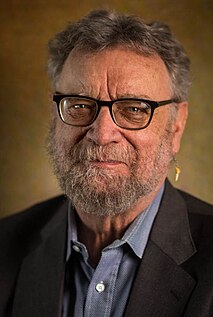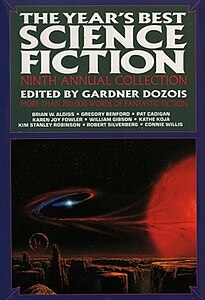
Pat Cadigan is an American science fiction author, whose work is most often identified with the cyberpunk movement. Her novels and short stories all share a common theme of exploring the relationship between the human mind and technology.

Vernor Steffen Vinge is an American science fiction author and retired professor. He taught mathematics and computer science at San Diego State University. He is the first wide-scale popularizer of the technological singularity concept and perhaps the first to present a fictional "cyberspace". He has won the Hugo Award for his novels and novellas A Fire Upon the Deep (1992), A Deepness in the Sky (1999), Rainbows End (2006), Fast Times at Fairmont High (2002), and The Cookie Monster (2004).

William Ford Gibson is an American-Canadian speculative fiction writer and essayist widely credited with pioneering the science fiction subgenre known as cyberpunk. Beginning his writing career in the late 1970s, his early works were noir, near-future stories that explored the effects of technology, cybernetics, and computer networks on humans—a "combination of lowlife and high tech"—and helped to create an iconography for the information age before the ubiquity of the Internet in the 1990s. Gibson coined the term "cyberspace" for "widespread, interconnected digital technology" in his short story "Burning Chrome" (1982), and later popularized the concept in his acclaimed debut novel Neuromancer (1984). These early works of Gibson's have been credited with "renovating" science fiction literature in the 1980s.

Gardner Raymond Dozois was an American science fiction author and editor. He was the founding editor of The Year's Best Science Fiction anthologies (1984–2018) and was editor of Asimov's Science Fiction magazine (1984–2004), garnering multiple Hugo and Locus Awards for those works almost every year. He also won the Nebula Award for Best Short Story twice. He was inducted to the Science Fiction Hall of Fame on June 25, 2011.

Michael Swanwick is an American science fiction author who began publishing in the early 1980s.

Omni was a science and science fiction magazine published in the US and the UK. It contained articles on science, parapsychology, and short works of science fiction and fantasy. It was published as a print version between October 1978 and 1995. The first Omni e-magazine was published on CompuServe in 1986 and the magazine switched to a purely online presence in 1996. It ceased publication abruptly in late 1997, following the death of co-founder Kathy Keeton; activity on the magazine's website ended the following April.

"Johnny Mnemonic" is a science fiction short story by American-Canadian writer William Gibson, which served as inspiration for the 1995 film of the same name. The short story first appeared in Omni magazine in May 1981, and was subsequently included in 1986's Burning Chrome, a collection of Gibson's short fiction. It takes place in the world of Gibson's cyberpunk novels, predating them by some years, and introduces the character Molly Millions, who plays a prominent role in Gibson's Sprawl trilogy of novels.

Terry Ballantine Bisson is an American science fiction and fantasy author. He is best known for his short stories, including "Bears Discover Fire", which won the Hugo Award and the Nebula Award, and "They're Made Out of Meat".

Virtual Light is a science fiction novel by American-Canadian writer William Gibson, the first book in his Bridge trilogy. Virtual Light is a science-fiction novel set in a postmodern, dystopian, cyberpunk future. The term 'Virtual Light' was coined by scientist Stephen Beck to describe a form of instrumentation that produces optical sensations directly in the eye without the use of photons. The novel was a finalist nominee for a Hugo Award, and shortlisted for the Locus Award in 1994.
The Bridge trilogy is a series of novels by William Gibson, his second after the successful Sprawl trilogy. The trilogy comprises the novels Virtual Light (1993), Idoru, (1996) and All Tomorrow's Parties (1999). A short story, "Skinner's Room", was originally composed for Visionary San Francisco, a 1990 museum exhibition exploring the future of San Francisco.

Allen Mulherin Steele, Jr. is an American journalist and science fiction author.

Sonia Orin Lyris is the author of several novels and various science fiction and fantasy stories and articles in computing and literary journals. She is the author of The Seer. and the sequel novels forming "The Stranger Trilogy". She has published fiction for Wizards of the Coast, Asimov's Science Fiction Magazine, and Pulphouse.

Lavie Tidhar is an Israeli-born writer, working across multiple genres. He has lived in the United Kingdom and South Africa for long periods of time, as well as Laos and Vanuatu. As of 2013, Tidhar lives in London. His novel Osama won the 2012 World Fantasy Award for Best Novel, beating Stephen King's 11/22/63 and George R. R. Martin's A Dance with Dragons. His novel A Man Lies Dreaming won the £5000 Jerwood Fiction Uncovered Prize, for Best British Fiction, in 2015. He won the John W. Campbell Memorial Award for Best Science Fiction Novel in 2017, for Central Station.

Daniel James Abraham, pen names M. L. N. Hanover and James S. A. Corey, is an American novelist, comic book writer, screenwriter, and television producer. He is best known as the author of The Long Price Quartet and The Dagger and the Coin fantasy series, and with Ty Franck, as the co-author of The Expanse series of science fiction novels, written under the joint pseudonym James S. A. Corey. The series has been adapted into the television series The Expanse (2015–present), with both Abraham and Franck serving as writers and producers on the show.
Michaela-Marie Roessner-Hermann is an American science-fiction writer publishing under the name Michaela Roessner.

The Year's Best Science Fiction: Ninth Annual Collection is a science fiction anthology edited by Gardner Dozois that was published in 1992. It is the 9th in The Year's Best Science Fiction series and won the Locus Award for best anthology.
"Burning Chrome" is a science fiction short story by Canadian-American writer William Gibson, first published in Omni in July 1982. Gibson first read the story at a science fiction convention in Denver, Colorado in the autumn of 1981, to an audience of four people, among them Bruce Sterling. It was nominated for a Nebula Award in 1983 and collected with the rest of Gibson's early short fiction in a 1986 volume of the same name.

Terry Carr's Best Science Fiction of the Year is an anthology of science fiction short stories edited by Terry Carr, the fourteenth volume in a series of sixteen. It was first published in paperback by Tor Books in July 1985, and in hardcover and trade paperback by Gollancz in October of the same year, under the alternate title Best SF of the Year #14.
















